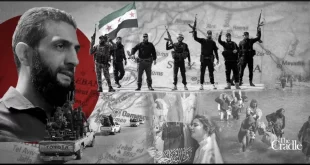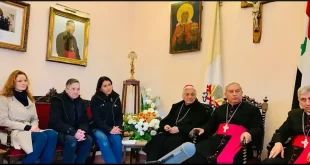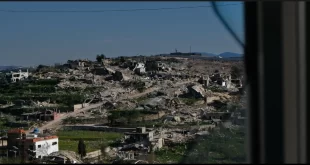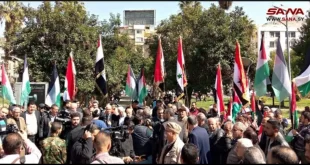Jul 12, 2015, Global Research
-Professor Tim Anderson
Washington’s plan for a New Middle East has hit a rock called Syria. After the invasions of Afghanistan and Iraq and the destruction of Libya, Syria was to be the next domino overthrown by a ‘colour revolution’, led by Islamists and backed by the big powers.
After ‘regime change’ in Damascus the next most powerful enemy of Israel, Hezbollah, leader of the Resistance in Lebanon, would be isolated and the Islamic Republic of Iran would remain the only Middle East country without US military bases. After Iran, the empire would control the entire region, excluding possible competitors such as Russia and China. Palestine would be lost.
But it was not to be. Coordinated resistance can never be discounted. Not only has Syria’s national army resisted wave after wave of fanatical Islamist attacks, Russian and Iranian backing has been solid. And new forms of cooperation with Iraq have emerged. Washington has worked for decades to divide Iran and Iraq, so the strengthening ties between Iran, Iraq, Syria, Lebanon and Palestine represent a threat to the new ‘Great Game’ of our times.
The US and its close regional collaborators (Saudi Arabia, Turkey, Qatar and Israel), we now know, have been behind every anti-Syrian extremist group since the beginning of the recent conflict. They have used the worst of reactionary and sectarian forces to further their ends. The Axis of Resistance, on the other hand, should not be misunderstood as a sectarian phenomenon. It is deeply anti-imperialist. Syria, the only remaining ‘secular’ (in Middle Eastern terms, pluralist) state in the region long allied itself with the Islamic Republic of Iran, including against Saddam Hussein’s secular Iraq. Saddam in turn was used byWashingtonto degradeIran, after that country’s 1979 revolution. On the other hand, Iran never backed the sectarian Muslim Brotherhood in any of its insurrections against Syria. Iran does support its fellow Shia Muslims of Hezbollah, but is most demonised for arming Palestine, which has hardly any Shia. Promotion of sectarianism in the Middle East has mostly come from Washington’s key allies, Saudi Arabia, the other gulf monarchies, and the ethnic cleansers of Israel. They share the aim of keeping the region weak and divided.
1. Behind Syria’s Islamist Insurrection
War always breeds lies, but the systematic deception of the dirty war on Syria has been remarkable. The western narrative was that peaceful protestors were brutalised by the Syrian ‘regime’ for six months before they finally decided to take up arms, in a democratic struggle. Only much later was this ‘revolution’ ‘hijacked’ by Islamists, they say. The Washington-based Human Rights Watch claimed: ‘the protest movement in Syria was overwhelmingly peaceful until September 2011′ (HRW 2012). However the late Jesuit priest Father Frans Van der Lugt, said ‘I have seen from the beginning armed protesters in those demonstrations … they were the first to fire on the police’ (Van der Lugt 2012). The western narrative, led by Washington and backed up by the corporate media, sought to cover that fact that the violent insurrection began immediately, taking cover under (rather than growing from) the political reform demonstrations, and that the violence from the beginning came from Saudi-backed sectarian Islamists.
To understand the violence in the southern border town of Daraa, in March 2011, we should look at a similar Islamist insurrection in the town of Hama, back in 1982. This comparison is useful because of myths that have grown up around both insurrections. Patrick Seale describes the outbreak of violence in Hama, on 2 February 1982:
‘An army unit combing the old city fell into an ambush. Roof top snipers killed perhaps a score of soldiers … [Muslim Brotherhood leader] ‘Abu Bakr’ [Umar Jawwad] gave the order for a general uprising … hundreds of Islamist fighters rose … by the morning some seventy leading Ba’athists had been slaughtered and the triumphant guerrillas declared the city ‘liberated’ (Seale 1988: 332).
However the Syrian Army responded with a huge force of about 12,000 and the battle raged for three weeks. The Brotherhood inHamawas crushed, along with many civilian collaborators. Two months later aUSintelligence report said: ‘The total casualties for theHamaincident probably number about 2,000. This includes an estimated 300 to 400 members of the Muslim Brotherhood’s elite ‘Secret Apparatus’ (DIA 1982: 7). Seale says ‘a figure of 5,000 to 10,000 could be close to the truth’ (Seale 1988: 335). Subsequent Muslim Brotherhood accounts inflated the casualties, often these days cited as a ‘massacre of 40,000 civilians’ (Nassar 2014).
The Hama insurrection helps us understand the recent conflict because, once again, we saw armed Islamists using rooftop sniping against police and government officials, drawing in the armed forces, only to cry ‘civilian massacre’ when they and their collaborators came under attack from the Army. While theUSplayed an important part in theHamainsurrection, routing money and arms to Salafi-Islamists through the Saudis, Jordan and Saddam Hussein, when it was all overUSintelligence dryly observed that: ‘the Syrians are pragmatists who do not want a Muslim Brotherhood government’ (DIA 1982: vii). Indeed.
After the attacks in Daraa, under cover of political reform demonstrations and counter-demonstrations, the Islamists moved up to Tartous, Homs and surrounding areas, eventually seizing parts of the old city of Homs. Front-line US collaborators, providing arms and money, were Saudi Arabia,Qatar and Turkey. Media backing came from Qatar’s Al Jazeera, Saudi Arabia’s Al Arabiya, and the various western corporate media. In the early daysIsrael, hated by all in the region, kept its head down.
Leader of the Muslim Brotherhood (by far the best organised opposition group), Muhammad Riyad Al-Shaqfa, issued a statement on 28 March saying the key enemy was ‘the secular regime’ and that Brotherhood members ‘have to make sure that the revolution will be pure Islamic, and with that no other sect would have a share of the credit after its success’ (Al-Shaqfa 2011). By the time there was a Free Syrian Army ‘Supreme Military Council’ it was two-thirds dominated by the Muslim Brotherhood (Draitser 2012). Other foreign Salafi-Islamist groups quickly joined in. Contrary to White House public statements, a US intelligence report of August 2012 admitted:
‘The Salafist, the Muslim Brotherhood and AQI [Al Qaeda inIraq, laterISIS] are the major forces driving the insurgency inSyria… AQI supported the Syrian Opposition from the beginning, both ideologically and through the media’ (DIA 2012).
In early 2011 there had been both anti-government and pro-government demonstrations, and a genuine political reform movement that for several years had agitated against corruption and the Ba’ath Party monopoly. However most did not want destruction of what was a socially inclusive if authoritarian state, and most were against both sectarian violence and the involvement of foreign powers. They backed Syria’s protection of minorities, the relatively high status of women and the country’s free education and health care, while opposing the corrupt networks and the feared political police (Wikstrom 2011; Otrakji 2012). Yet within several weeks those demonstrators were driven off the streets by the violence. For example, a demonstration of 5,000 at Ma’arrat al-Numan (north-west Syria), against the killing of several people, became a rally of 350 a few days later, after Islamist attacks killed and wounded a large number of police (Jaber 2011).
Saudi official Anwar Al-Eshki confirmed to BBC television that his country had sent arms to Daraa and to the al-Omari mosque (Truth Syria 2012). The genocidal slogan ‘Christians toBeirut, Alawites to the grave’ became widespread, a fact reported by the North American media as early as May 2011 (Blanford 2011). While western experts such as the International Crisis Group called the Farouq Brigade part of ‘a moderate Islamic tradition’ (ICG 2012), that same group chanted the Salafist slogan while killing pro-government people and ethnically cleansing tens of thousands of Christians from Homs (Crimi 2012).
A numbers game was underway to delegitimise the Syrian Government (‘The Regime’) and the Syrian Arab Army (‘Assad loyalists’), suggesting they were responsible for all the violence. Any soldier casualties were reported as ‘defectors’ killed by ‘the regime’. Yet journalist Nir Rosen, whose reports were generally critical of the Syrian Government, attacked this particular western consensus:
‘The issue of defectors is a distraction. Armed resistance began long before defections started … Every day the opposition gives a death toll, usually without any explanation … Many of those reported killed are in fact dead opposition fighters but … described in reports as innocent civilians killed by security forces’ (Rosen 2012).
The big powers rapidly moved into ‘regime change’ mode. Secretary of State Hilary Clinton claimed ‘the vast majority of casualties have been unarmed civilians’ (Clinton 2011). This was quite wrong. The United Nations estimated from several sources that, by early 2012, there were more than 5,000 casualties, and that deaths in the first year of conflict included 478 police and 2,091 from the military and security forces (OHCHR 2012: 2; Narwani 2014). That is, more than half the casualties in the first year were from the Syrian security forces.
The propaganda war helped build the basis for gradually increasing levels of intervention, through literally hundreds of armed groups. After the defeat of Farouq inHomsin early 2012, thousands of foreign Islamists flooded throughTurkeyinto northernSyria, occupying parts ofAleppo. Moral pressure was kept up with a series of allegations that the Syrian Army was engaged in repeated attacks on civilians.
2. Demonising Bashar
Key to delegitimising the Syrian Government were attacks on President Bashar al Assad. If we believed western media reports we would think that Assad had launched repeated and indiscriminate bombing of civilian areas, including the gassing of children. We might also think he heads an ‘Alawi regime’, where a 12% minority represses a Sunni Muslim majority. The problem with that is his great popularity inSyria. Even his enemies recognised that fact.
In January 2011 the Qatari channel Al Jazeera concluded that a revolution inSyriawas ‘unlikely’ due to Assad’s popularity. While there was authoritarian rule, ‘factors such as a relatively popular president and religious diversity make an uprising in the country unlikely.’ Bashar was popular amongst young people, saidUSanalyst Joshua Landis.
‘They may not like the regime, they don’t like corruption … but they tend to blame this on the people around him, the old guard’. People wanted change, because of poverty, corruption and the political police; but Syrians liked Assad’s support for pluralism and modernising reforms (Wikstrom 2011).
A poll in late 2011 byQatarshowed that a 51% majority of Syrians wanted Assad to stay (Doha Debates 2011). Islamist fighters inAleppowere more emphatic. Three Free Syrian Army leaders (all of whom collaborated with al Qaeda groups) said the Syrian President had at least ‘70 percent’ support in that city (Bayoumy 2013). The local people, ‘all of them, are loyal to the criminal Bashar, they inform on us’ (Abouzeid 2012); they are ‘all informers … they hate us. They blame us for the destruction’ (Abdul-Ahad 2012). Unpopularity is fatal to a revolution; to a religious fanatic it is merely inconvenient. An internal NATO study in 2013 estimated that 70% of Syrians supported the President, 20% were neutral and 10% supported the ‘rebels’ (World Tribune 2013; BIN 2013).
The Presidential elections of 2014, ferociously opposed by western governments, were an eye-opener. A referendum had removed the Baath Party’s monopoly and, for the first time, Assad faced a competitive election. He won convincingly. The world media recognised the massive turnout, both inSyriaand from refugees in Lebanon (FNA 2014a; FNA 2014b). Election observers came fromIndia,Brazil,Russia,China,South Africa,Iran and Latin America, along with non-official observers from theUSA and Canada (KNN 2014). Most western sources simply asserted that the elections could not be ‘free and fair’, but some grudgingly admitted that ‘getting people to turn out in large numbers, especially outsideSyria, is a huge victory in and of itself’ (Dark 2014). Indeed, the participation rate in Syria’s 2014 wartime election (73.4%) was far higher than any presidential election in theUSA(between 52% and 60%) (Idea International 2015a, 2015b).
Despite this, the western media kept relying on Islamist ‘activists’, and Muslim Brotherhood exiles such the UK-based Rami Abdul Rahman, (the self-styled ‘Syrian Observatory of Human Rights’), to maintain their war narrative. They kept ‘Bashar the Monster’ alive, outsideSyria. The Syrian President was said to have directed a series of appalling civilian massacres.
For example, the massacre of more than 100 mostly pro-government villagers at Houla (just outsideHoms) was used to expel Syrian diplomats and impose draconian sanctions on the country. A subsequent investigation by a UN team led by Norwegian General Robert Mood heard two distinct stories. Mood offered to help with further inquiries (Mood 2012), but his team was wound up, its report buried (UNSG 2012; Hauben 2012). A second UN group co-chaired by US diplomat Karen Koning AbuZayd, blamed un-named pro-government groups (HRC 2012: 67). No motive was given. I have compiled detail of the many eye-witness accounts of the Houla massacre, concluding that the lead perpetrators were the remnants of the Farouq Brigade, fleeing from Homs (Anderson 2015a).
Other ‘false flag’ massacres were exposed by western sources. After the August 2012 massacre of 245 people in Daraya, western media reported that ‘Assad’s army has committed [another] massacre’ (Oweis 2012). However Robert Fisk observed that the FSA had slaughtered kidnapped civilian and off-duty soldier hostages after a failed prisoner swap (Fisk 2012). Similarly, the10 December 2012massacre of 120 to 150 villagers in Aqrab (less than 15 kilometres from Houla, and also under ‘rebel’ control) was blamed on the Syrian Government. The New York Times suggested ‘members of Assad’s sect’ were responsible (Stack and Mourtada 2012). In fact, they were the victims. British journalist Alex Thompson (2012) later reported the FSA had held 500 Alawi villagers for nine days, murdering many of them as the army closed in and the gang fled.
The most highly politicised atrocity was the chemical attack of August 2013, in the Eastern Ghouta region, outside Damascus. All of the claims implicating the Syrian Army in this incident have been thoroughly discredited (see Anderson 2015b). For example, MIT investigators Lloyd and Postol (2014) concluded that the sarin gas rockets ‘could not possibly have been fired … from Syrian Government controlled area’. Nevertheless the western media mostly proceeded on the false premise that the initial accusations were fact.
Quite a number of Syrians have criticised President Assad to me, but not in the manner of the western media. They say they wanted him to be as firm as his father. Many inSyriaregard him as too soft, leading to the name ‘Mr Soft Heart’. Soldiers in Damascus told me there is an Army order to make special efforts to capture alive any Syrian combatant. This is controversial, as many regard them as traitors, no less guilty than foreign terrorists. What happens to the latter is another story. While there is no credible, independent evidence of attacks on civilians by the Syrian Army there is strong evidence that the Army has executed captured terrorists. This is certainly a war crime, but it is probably quite popular inSyria, in the current circumstances.
3. The character of the Syrian Conflict
Informed critics have all noted that the Syrian conflict is principally between a pluralist state and sectarian Islamists, backed by the big powers. To Washington this was to be the next step in their plan for a ‘New Middle East’. But with Syria the Empire hit a rock. The consequences for the region could be profound.
Sami Ramadani, Iraqi exile and now an academic in Britain, is a severe critic of the government, maintaining Syria has been run by ‘a ruthless, corrupt regime’ with a feared ‘security apparatus’. However, he says, because ‘reactionary forces’ backed bySaudi Arabia and Qatar very rapidly took over from the ‘democratic resistance’, popular support shifted back to the government (Ramadani 2012). He also says the idea thatSyriais a sectarian Alawite regime ‘is highly exaggerated’. The government had ‘much wider circles of support’, including influential Sunni classes and ‘millions of women’ who fear the Salafis. Further, many of ‘the poor, the unemployed and students’ who at first backed the protest movement, were repulsed by groups such as the exile Syrian National Council and the Free Syrian Army, which were ‘dominated by the Brotherhood’ (Ramadani 2012).
Despite the repeated deceptions of past wars, many in western societies remain confused. The deep racism of imperial culture aims to create a cultural void into which the big powers can step as protectors and saviours, hiding their own strategic interests. The western left is also caught up in this. Many have their own ideas on how to ‘save’SyriaandIraq.
TheMiddle East itself is far from any level of unity, with the sectarian card still being used to divide and weaken. Nevertheless, the intensity of the conflict, the mass slaughter and the deep resentment at the big powers is building a new regional anti-imperialism. We saw this when Iraqi forces went into Tikirit againstISIS, taking with them Iranian forces and leaving US troops behind inBaghdad. We see it in the growing security cooperation betweenBaghdadandDamascus. Renewed constructive links between Damascus, Baghdad and Tehran do not bode well for Washington’s New ‘Middle East’. But that is most likely the only viable future for the peoples of the region.
 Syria Support Movement solidarity with the Syrian people
Syria Support Movement solidarity with the Syrian people




